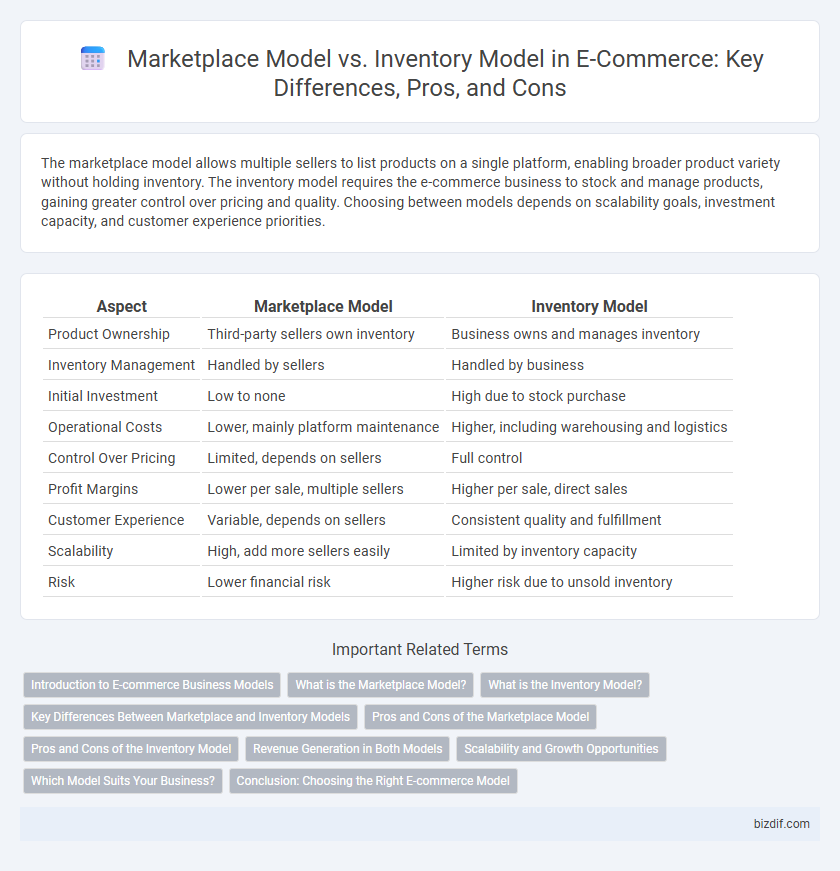The marketplace model allows multiple sellers to list products on a single platform, enabling broader product variety without holding inventory. The inventory model requires the e-commerce business to stock and manage products, gaining greater control over pricing and quality. Choosing between models depends on scalability goals, investment capacity, and customer experience priorities.
Table of Comparison
| Aspect | Marketplace Model | Inventory Model |
|---|---|---|
| Product Ownership | Third-party sellers own inventory | Business owns and manages inventory |
| Inventory Management | Handled by sellers | Handled by business |
| Initial Investment | Low to none | High due to stock purchase |
| Operational Costs | Lower, mainly platform maintenance | Higher, including warehousing and logistics |
| Control Over Pricing | Limited, depends on sellers | Full control |
| Profit Margins | Lower per sale, multiple sellers | Higher per sale, direct sales |
| Customer Experience | Variable, depends on sellers | Consistent quality and fulfillment |
| Scalability | High, add more sellers easily | Limited by inventory capacity |
| Risk | Lower financial risk | Higher risk due to unsold inventory |
Introduction to E-commerce Business Models
Marketplace model in e-commerce connects multiple sellers with buyers on a single platform, facilitating transactions without holding inventory, which reduces operational costs and expands product variety. Inventory model involves the e-commerce company purchasing, storing, and managing products before selling directly to customers, offering greater control over quality and customer experience. Choosing between marketplace and inventory models depends on factors like capital investment, logistics capabilities, and desired level of control over the supply chain.
What is the Marketplace Model?
The Marketplace Model in e-commerce enables multiple third-party sellers to list and sell products on a single platform without owning the inventory. This model facilitates a diverse product range, enhances customer choice, and reduces operational costs for the platform operator. It leverages technologies like secure payment gateways and real-time order tracking to streamline transactions between buyers and sellers.
What is the Inventory Model?
The Inventory Model in e-commerce involves the retailer purchasing, storing, and managing products in their own warehouse before selling them directly to customers. This model provides greater control over inventory, pricing, and product quality, enabling faster shipping and enhanced customer experience. Retailers using this approach must invest in inventory management systems, warehousing, and supply chain logistics to maintain stock levels and fulfill orders efficiently.
Key Differences Between Marketplace and Inventory Models
The Marketplace model connects buyers and sellers directly, facilitating transactions without holding inventory, resulting in lower operational costs and broader product variety. In contrast, the Inventory model involves the e-commerce platform owning and managing stock, enabling greater control over product quality, pricing, and fulfillment speed. Key differences include inventory risk management, platform scalability, and revenue generation methods such as commission-based earnings in marketplaces versus margin-based profits in inventory-driven stores.
Pros and Cons of the Marketplace Model
The Marketplace Model offers scalability and lower operational costs by connecting buyers and sellers without holding inventory, enabling diverse product offerings and reduced risk. However, challenges include limited control over product quality, shipping times, and customer service, which may impact brand reputation and customer satisfaction. Sellers face intense competition and dependency on platform policies, while the marketplace owner must ensure stringent seller vetting and dispute resolution mechanisms.
Pros and Cons of the Inventory Model
The Inventory Model enables e-commerce businesses to control product quality, pricing, and shipping, leading to better customer experience and brand consistency. However, it requires significant upfront investment in inventory management, warehousing, and logistics, increasing operational costs and financial risk due to unsold stock. Limited flexibility in product range and slower adaptation to market trends are additional challenges compared to the Marketplace Model.
Revenue Generation in Both Models
The Marketplace Model generates revenue primarily through commissions, listing fees, and advertising, allowing multiple sellers to reach a broad customer base without holding inventory, thus reducing overhead costs. In contrast, the Inventory Model drives revenue through direct product sales, enabling higher control over pricing and customer experience but requiring significant investment in stock and logistics management. Both models offer distinct revenue streams, with the Marketplace leveraging scalability and low capital requirements, while the Inventory Model benefits from margin control and brand consistency.
Scalability and Growth Opportunities
The marketplace model offers superior scalability by connecting numerous sellers and buyers without the need to manage stock or logistics, facilitating rapid expansion into new markets. In contrast, the inventory model requires significant investment in warehousing and supply chain management, which can limit growth pace and increase operational complexity. Marketplaces benefit from network effects, driving exponential growth opportunities through diverse product offerings and reduced capital expenditure.
Which Model Suits Your Business?
The Marketplace Model suits businesses seeking low upfront investment and scalability by connecting multiple sellers to a wide customer base without managing inventory. The Inventory Model fits companies aiming for full control over product quality, branding, and customer experience through direct handling of stock and logistics. Choosing the right model depends on factors like capital availability, supply chain capabilities, and long-term growth strategy in the e-commerce sector.
Conclusion: Choosing the Right E-commerce Model
Choosing the right e-commerce model depends on factors such as control over product inventory, scalability, and customer experience priorities. The marketplace model offers wide product variety with minimal inventory risk, while the inventory model provides greater control over stock and branding. Businesses must evaluate logistics capabilities, capital investment, and desired level of customer interaction to determine the optimal approach for growth and profitability.
Marketplace Model vs Inventory Model Infographic

 bizdif.com
bizdif.com